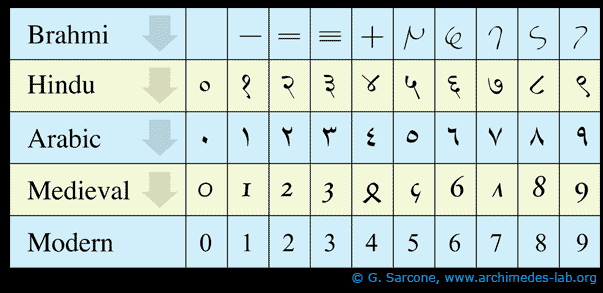The shape of the zero was very clever indeed. When you draw it...it starts as nothing, becomes a point and then takes a shape and then the point returns to nothing, the point at which it came. The numerical shape returns to itself, returns the shape of zero, returns to nothing.
Now, I find it confusing that eight uses the zero doubled up. That number really should have been another symbol.
I find it more confusing that the number ten, twenty, and so on use the number zero at all. There is no zero involved in ten or twenty. There is a one involved in ten. One row of ten. There is a two involved in twenty. Two rows of ten. But why zero?
Then we have infiniti. The horizontal figure eight. This makes sense as it is zero. It is nothing, becoming something and returning to nothing again. But because it is infinite, it does it again. Like a cycle. This makes a lot of sense.
So, who was behind the symbol of zero and infiniti and who was behind the symbol of eight and ten, and twenty, and so on?
Well, as it turns out the symbol we use today for zero came from the Hindu symbol of zero. This is interesting, because their concept of nothingness is still relevant today, especially given the new developments of what nothing means in quantum physics, in the true reality of nature.
Hindus only, within the context of Indo-European, have consistently used a zero.
But we can see that the Hindus did not use the two-zero format for the eight originally. That evolved later during Medieval times. I have to say that was a mistake. The symbol doesn't make sense.
What about ten, twenty and so forth?
Even though it doesn't make sense to me to use a zero, because there is no zero in the number quantity, of course this makes sense so that place values are used and therefore we can write any number using just ten symbols.
But it may have been better to isolate zero as its own symbol, and use a different symbol for ten, twenty. Perhaps like this 1~ or 2~ to mean ten and twenty. 11~ would mean one hundred and ten.
I just don't like the combination of something and nothing I guess. But, the place value was an important step.
What about infiniti? The symbol apparently came to us by John Mallis in 1655.
Wallis did not explain his choice of this symbol, but it has been conjectured to be a variant form of a Roman numeral for 1,000 (originally CIƆ, also CƆ), which was sometimes used to mean "many", or of the Greek letter ω (omega), the last letter in the Greek alphabet.(wiki)






